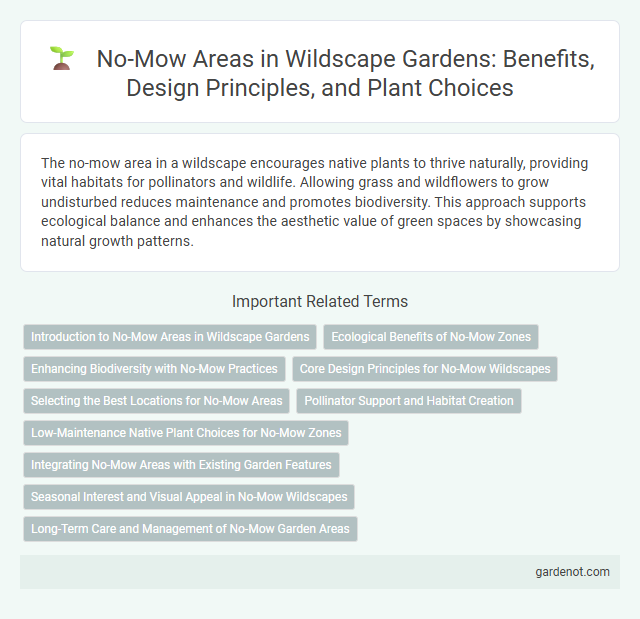The no-mow area in a wildscape encourages native plants to thrive naturally, providing vital habitats for pollinators and wildlife. Allowing grass and wildflowers to grow undisturbed reduces maintenance and promotes biodiversity. This approach supports ecological balance and enhances the aesthetic value of green spaces by showcasing natural growth patterns.
Introduction to No-Mow Areas in Wildscape Gardens
No-mow areas in Wildscape gardens provide essential habitats for native wildlife by allowing natural vegetation to grow undisturbed. These zones encourage biodiversity by supporting pollinators, birds, and beneficial insects while reducing maintenance and water usage. Establishing no-mow sections helps recreate native ecosystems, promoting ecological balance within urban and suburban landscapes.
Ecological Benefits of No-Mow Zones
No-mow areas create vital habitats for pollinators, including bees and butterflies, by preserving native wildflowers and grasses. These zones enhance soil health through increased organic matter and root diversity, reducing erosion and promoting carbon sequestration. By minimizing lawn maintenance, no-mow areas also decrease fossil fuel emissions and chemical runoff, contributing to improved local biodiversity and ecosystem resilience.
Enhancing Biodiversity with No-Mow Practices
No-mow areas significantly enhance biodiversity by providing native plants and wildflowers the opportunity to flourish, supporting pollinators like bees and butterflies essential for ecosystem health. These undisturbed habitats create shelters and breeding grounds for various insects, birds, and small mammals, fostering balanced wildlife populations. Reduced mowing also improves soil quality by preserving organic matter and promoting beneficial microorganisms critical to natural nutrient cycles.
Core Design Principles for No-Mow Wildscapes
No-mow areas in wildscapes prioritize biodiversity by allowing native plants to thrive, creating essential habitats for pollinators and wildlife. Core design principles include selecting site-appropriate species, maintaining structural diversity, and minimizing disturbance to foster natural ecological processes. Implementing buffer zones and varying plant heights enhances habitat complexity, supporting ecosystem resilience and promoting sustainable urban green spaces.
Selecting the Best Locations for No-Mow Areas
Choosing the best locations for no-mow areas involves identifying spots with high ecological value, such as native wildflower patches or habitats for pollinators and local wildlife. Areas that are less trafficked by people and equipment reduce disturbance, allowing native plants and beneficial insects to thrive. Selecting sites with varied sunlight, soil moisture, and minimal invasive species pressure ensures the long-term success of these naturalized zones.
Pollinator Support and Habitat Creation
No-mow areas within wildscapes provide essential habitats that support diverse pollinator populations, including bees, butterflies, and other beneficial insects. These zones offer rich sources of nectar and pollen, contributing to the restoration of declining pollinator species and enhancing local biodiversity. Maintaining no-mow patches encourages native plant growth, which creates shelter and breeding grounds crucial for sustaining healthy ecosystems.
Low-Maintenance Native Plant Choices for No-Mow Zones
Low-maintenance native plant choices for no-mow zones enhance biodiversity while reducing upkeep in Wildscape designs. Native grasses, wildflowers, and sedges such as little bluestem, black-eyed Susan, and Pennsylvania sedge thrive in no-mow areas, supporting pollinators and wildlife habitat. These plants naturally adapt to local soil and climate conditions, minimizing irrigation and fertilizer needs for sustainable, eco-friendly landscapes.
Integrating No-Mow Areas with Existing Garden Features
Integrating no-mow areas with existing garden features enhances biodiversity by creating seamless transitions between manicured lawns and natural habitats. Positioning native plants and wildflowers around garden beds and pathways encourages pollinators while reducing maintenance. Strategic placement near water features or shaded spots supports various wildlife species, boosting ecological balance within the wildscape.
Seasonal Interest and Visual Appeal in No-Mow Wildscapes
No-mow wildscapes create seasonal interest by showcasing a dynamic palette of native plants that evolve throughout the year, offering vibrant blooms in spring and summer, and rich seed heads and foliage textures in fall and winter. These areas support diverse wildlife habitats, attracting pollinators like bees and butterflies while providing visual appeal with naturalistic layers of grasses, wildflowers, and shrubs. Incorporating no-mow zones enhances sustainability by reducing maintenance and fostering ecological balance in residential or public landscapes.
Long-Term Care and Management of No-Mow Garden Areas
Long-term care of no-mow garden areas in wildscapes involves minimal disturbance to promote native plant growth and biodiversity. Regular monitoring for invasive species and selective removal maintains ecological balance without the need for mowing. Soil health is improved through organic mulching and controlled foot traffic, ensuring sustainable habitat development over time.
No-mow area Infographic

 gardenot.com
gardenot.com